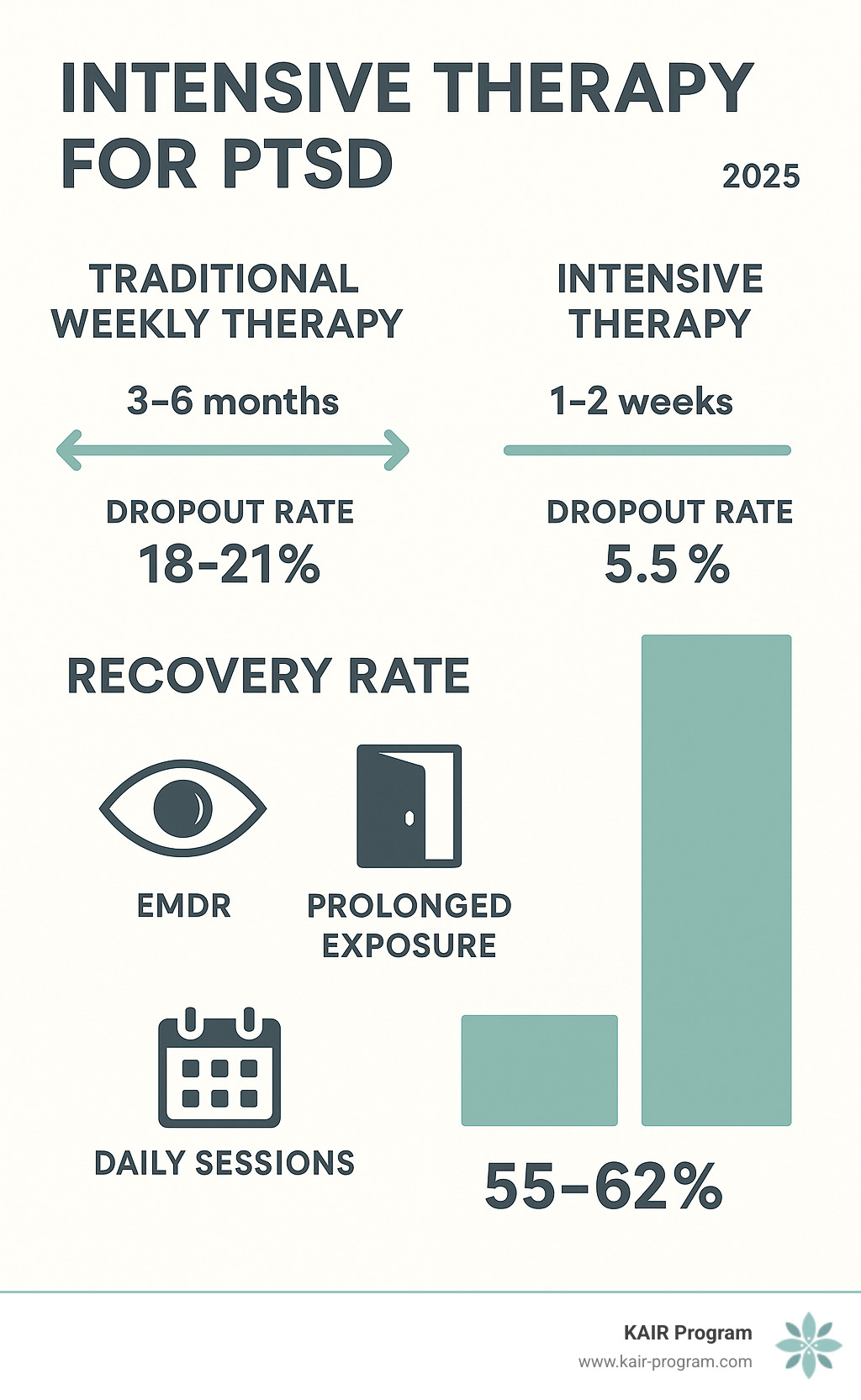Fast-Track Your Recovery with Intensive Therapy for PTSD
Why Intensive Therapy for PTSD is Revolutionizing Trauma Recovery

Intensive therapy for PTSD is an accelerated treatment that delivers concentrated trauma-focused sessions over days or weeks, not months or years. This evidence-based method combines multiple therapeutic modalities in an immersive format, achieving remarkable results that traditional weekly therapy often struggles to match.
Key Features of Intensive PTSD Therapy:
- Duration: 1-2 weeks of concentrated treatment vs. 3-6 months of weekly sessions
- Format: 3-8 hours of therapy per day in a focused environment
- Dropout Rate: Only 5.5% compared to 18-21% in traditional therapy
- Recovery Rate: 55-62% of patients show clinically significant improvement
- Modalities: Combines EMDR, Prolonged Exposure, Cognitive Processing Therapy, and psychoeducation
For many with PTSD, healing feels endless. Traditional weekly therapy can be slow and fragmented, with life's demands derailing momentum between sessions. Intensive therapy offers a research-backed alternative, condensing months of healing into a shorter timeframe with significantly higher success and lower dropout rates.
As Dr. Bambi Rattner, PsyD, I've witnessed how intensive therapy for PTSD transforms lives. After decades of clinical practice and specialized training in EMDR and Progressive Counting, I've seen the profound healing that occurs when we create the time and space for intensive trauma work.

The Pervasive Nature of Trauma
Trauma is a common human experience, with research showing 61% to 80% of people will face at least one traumatic event. These events can range from accidents and natural disasters to assault, combat, or long-term abuse. While most people are resilient, about 5% to 10% of those exposed to trauma develop Post-Traumatic Stress Disorder (PTSD).
PTSD doesn't affect everyone equally; women and people assigned female at birth (AFAB) are twice as likely to develop it as men and people assigned male at birth (AMAB). The impact of PTSD on daily life can be debilitating, but there is profound hope. Effective treatments like intensive therapy for PTSD are a powerful avenue for healing and reclaiming your life.
What is Intensive Trauma Therapy and How Does It Work?
Intensive therapy for PTSD concentrates healing into days or weeks of focused work, rather than spreading it across months of weekly sessions. This approach uses "massed sessions"—multiple hours of therapy each day over a compressed timeframe—to create an immersive healing workshop. This format prevents life's distractions from derailing progress and doesn't give trauma the breathing room to reassert itself between appointments.
| Feature | Intensive PTSD Therapy | Traditional Weekly Therapy |
|---|---|---|
| Duration | Days to 2 weeks | Months to years |
| Session Frequency | Multiple sessions/hours per day | One 45-60 minute session per week |
| Total Therapy Hours | ~18-30+ hours over a short period | ~18-30+ hours spread over many months/years |
| Dropout Rate | Significantly lower (e.g., 5.5%) | Higher (e.g., 18-21%) |
| Momentum | High; builds quickly | Can be fragmented; easily derailed between sessions |
| Focus | Deep, continuous trauma processing | Often includes coping, stabilization, and gradual processing |
| Environment | Immersive, dedicated healing space | Outpatient, integrated into daily life |
The Core Difference: A Condensed Timeline
The condensed timeline is powerful because it breaks the cycle of avoidance that fuels PTSD. With weekly sessions, it's easy to avoid difficult topics between appointments. Intensive therapy for PTSD keeps you consistently engaged, building therapeutic momentum as each session flows into the next. This focused processing allows you to work through traumatic memories more thoroughly until you reach a resolution. The appeal is clear: research shows that 38.2% of patients choose the intensive format when given the option, preferring to tackle the hardest work in a concentrated period.
A Look Inside an Intensive PTSD Therapy Program
A day in an intensive program typically involves 3 to 8 hours of therapy, with breaks for integration. The structure is designed for deep healing, not to overwhelm. A typical day might combine:
- Individual and group therapy sessions for one-on-one work and peer support.
- Psychoeducation to understand how trauma affects the brain and body.
- Skill-building exercises for managing stress, regulating emotions, and responding to triggers.
In this immersive environment, you step away from daily stressors to focus completely on recovery. Many programs feature dedicated therapists, sometimes in a team rotation model, to ensure you receive consistent, high-quality care.
Core Therapeutic Techniques Used in Intensive Programs
The power of intensive therapy for PTSD lies in its integration of proven, evidence-based treatments into a concentrated healing experience. The effectiveness comes from combining multiple therapeutic modalities in a safe, supportive environment that allows for deep, uninterrupted work.
Gold-Standard Trauma-Focused Psychotherapies
The backbone of any effective program is gold-standard therapies that are rigorously tested and proven to work.
- Prolonged Exposure (PE): This therapy helps you gradually face memories and situations you've been avoiding. Through guided exposure, you learn that these trauma reminders are not dangerous, which reduces their power.
- Cognitive Processing Therapy (CPT): CPT focuses on the distorted thoughts and beliefs that trauma creates, such as "I am helpless" or "the world is unsafe." It helps you challenge these thoughts with balanced, evidence-based thinking.
- Eye Movement Desensitization and Reprocessing (EMDR): EMDR uses bilateral stimulation (like eye movements) while you recall distressing memories. This helps your brain reprocess traumatic events, reducing their emotional charge. Intensive EMDR treatment has shown reliable improvement in PTSD symptoms and is effective for complex cases.
Complementary and Supportive Elements
Intensive programs also include supportive elements to build resilience and maintain progress. These are not just add-ons; they are essential for a comprehensive healing experience.
- Mindfulness and Somatic Experiencing: These practices help you stay grounded and release trauma stored in the body.
- Physical Activity: Exercise contributes to better physical health and stress management.
- Skill Building: You'll learn stress management skills and develop a relapse prevention plan.
- Aftercare Support: Healing continues after the intensive phase, so programs often include follow-up sessions or connect you with local therapists.
Who is an Ideal Candidate for Intensive Therapy for PTSD?
While intensive therapy for PTSD offers rapid healing, it's not the right fit for everyone. A thorough screening process is essential to ensure this accelerated path is safe and effective for your unique situation. It's about finding the approach that gives you the best chance for lasting recovery.

Profile of a Suitable Candidate
People who thrive in intensive programs often share certain qualities. You may be a great candidate if you have:
- High motivation for change and are ready to engage fully in the process.
- A stable living environment and support system to help you integrate the work.
- The ability to take time off from work and other duties for a concentrated period.
- A desire for rapid symptom relief from severe PTSD symptoms.
- Logistical challenges with weekly therapy, such as distance or work schedules. Certain demographic factors can also make traditional therapy less accessible.
- A history of treatment-resistant PTSD, where previous therapies have not been successful.
Types of Trauma Addressed by intensive therapy for ptsd
A major benefit of intensive therapy for PTSD is its versatility. It is effective for healing from various types of trauma, including:
- Single-incident trauma: Events like motor vehicle accidents, natural disasters, or violent attacks.
- Complex PTSD (C-PTSD): Resulting from chronic experiences like childhood abuse, domestic violence, or combat exposure. Recent research shows that people with C-PTSD respond very well to intensive treatment, offering a faster path to healing than previously thought.
- Combat and first-responder trauma: The concentrated format allows for deep processing of multiple traumatic incidents.
- Sexual assault and domestic violence: The focused nature of the program allows for careful, thorough processing of these deeply personal traumas.
If PTSD symptoms are interfering with your life, an intensive approach can provide the focused care needed for profound healing, regardless of the trauma's origin.
The Proven Effectiveness and Benefits of Intensive Treatment
The research on intensive therapy for PTSD delivers solid, measurable results. Data consistently shows that this concentrated, immersive treatment often works better than traditional approaches, leading to genuine, lasting change in a fraction of the time.

Remarkable Recovery Rates and Lasting Outcomes
The statistics on intensive PTSD programs are remarkable.
- Studies show that 55% to 62% of patients achieve clinically significant recovery after just an 8-day program.
- Even more impressively, 50% of patients in one 8-day program lost their PTSD diagnosis entirely.
- These improvements are not temporary. A systematic review shows high patient satisfaction and retention of gains up to 12 months post-treatment.
The power of this focused approach is clear: creating dedicated time for healing allows breakthroughs to happen more quickly and completely.
Why Choose an Intensive Model?
Beyond the impressive statistics, there are practical benefits to choosing intensive therapy for PTSD:
- Faster Relief: Get significant symptom reduction in days or weeks, not months.
- Higher Completion Rates: The dropout rate is just 5.5%, compared to 18-21% for traditional therapy. You're more likely to see the treatment through.
- Better Logistics: Taking a week or two off can be easier than scheduling weekly appointments for months, especially if you live far from a qualified therapist.
- Immersive Environment: A focused setting protects the healing process from daily life stressors and prevents the loss of therapeutic momentum.
Considerations and How to Find a Qualified Program
While intensive therapy for PTSD offers incredible promise, it's important to approach it with realistic expectations. It's a powerful tool that requires proper preparation.
Challenges and Factors to Consider
Intensive therapy is faster, not necessarily easier. It requires real commitment. Key considerations include:
- Financial Investment: The upfront cost can be significant, though the total may be comparable to long-term weekly therapy.
- Time Commitment: You'll need to clear your schedule for days or weeks, arranging time off from work and other duties.
- Emotional Intensity: Processing trauma in a concentrated way is exhausting but is also what leads to breakthroughs.
- Support System: A strong support network is crucial for integrating the work after the program.
- Aftercare: Post-treatment integration is essential. Quality programs emphasize follow-up sessions to maintain progress.
Finding a Qualified Provider for intensive therapy for ptsd
Choosing the right provider is a critical step. Here's what to look for:
- Credentials and Licensing: Ensure your therapist is a licensed professional.
- Trauma Specialization: Seek a provider with specific training and expertise in PTSD.
- Experience with Intensive Formats: Ask about their experience running concentrated programs.
- Evidence-Based Modalities: A quality program should use proven therapies like EMDR, PE, or CPT.
- Pre-Treatment Consultation: A reputable provider will offer a consultation to ensure you're a good fit and to answer your questions.
At the KAIR Program, we specialize in ketamine-assisted intensive retreats, integrating psychedelic medicine with trauma-focused therapy for rapid, lasting healing, especially for treatment-resistant conditions. Our unique approach creates a deeply immersive and transformative healing experience that goes beyond traditional intensive therapy models.
For additional support, these organizations can provide valuable assistance:
- Combat Stress for veterans
- Rape Crisis for survivors of sexual violence
- Victim Support for victims of crime
Finding the right program is about feeling safe, understood, and supported. Take your time with this important decision.
Conclusion
Intensive therapy for PTSD offers a powerful, evidence-based path to healing that condenses months of therapy into days or weeks. With remarkably low dropout rates, rapid symptom reduction, and lasting results, it provides a focused, supportive environment to build therapeutic momentum that sticks.
If you're tired of feeling stuck, and traditional therapy hasn't provided the relief you need, an intensive program offers a different path—one that respects your time and your urgent need to heal. This isn't just about managing symptoms; it's about reclaiming your life from trauma.
The investment in an intensive program is an investment in your future. Taking the first step takes courage, but you don't have to do it alone. The right program will guide you toward the healing you deserve.
Learn more about our intensive healing retreats and find how ketamine-assisted therapy can accelerate your path to recovery.

